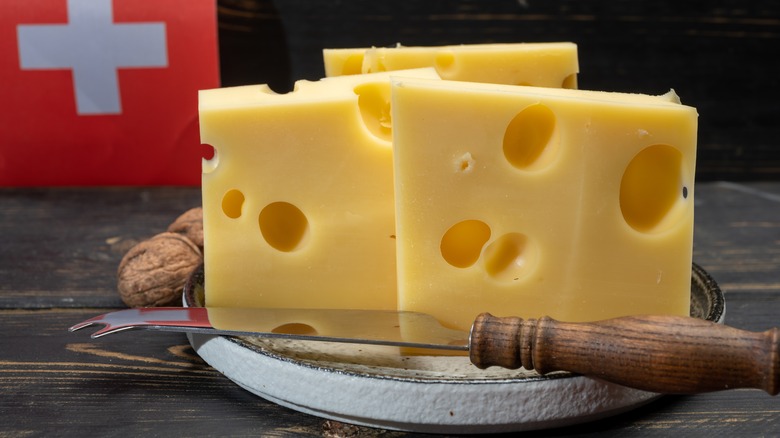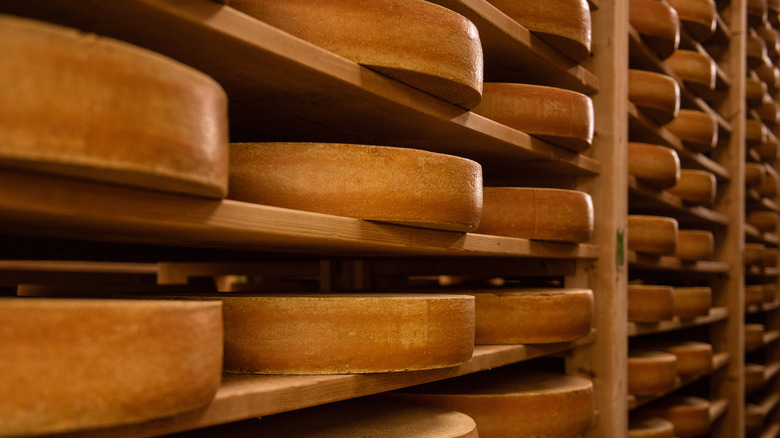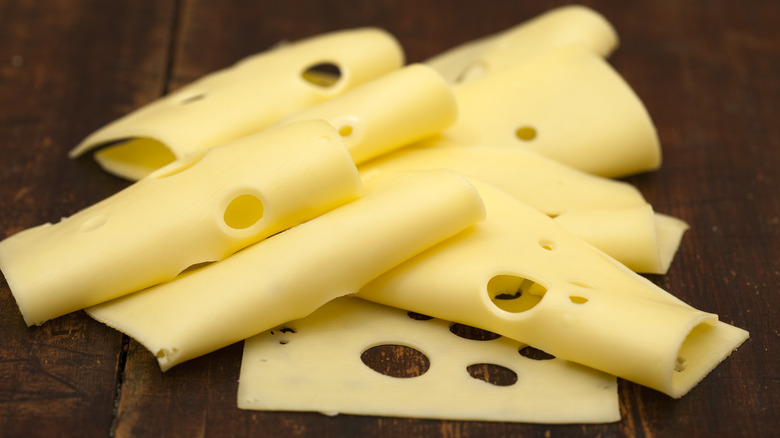The Scientific Reason Swiss Cheese Has Its Holes
Most of the traditional explanations for the shape of Swiss cheese have — if you'll pardon the expression — holes in them. No, these holes are not the result of hungry mice; they're not solely from carbon dioxide, either (although some cheesemakers and scientists long held this belief).
The theory linking carbon dioxide to the holes does have a scientific basis, but it's not entirely accurate. In 1917, American scientist William Clark hypothesized that the bacteria present in milk used for Swiss cheese production released carbon dioxide, and this gas formation was responsible for creating the characteristic holes — also known as "eyes" — in the cheese. However, more recent research has offered a different explanation that is less whimsical than the idea of hungry mice. According to Swiss scientists from the Agroscope Institute for Food Sciences and the Swiss Federal Laboratories for Materials Science and Technology, the holes are actually caused by a combination of carbon dioxide and hay particles.
Back in the good old days, Swiss cheese like Emmentaler was made in barns, where hay particles would find their way into the milk buckets, leading to the formation of these holes. Modern, more sterile methods of cheese production are less likely to produce these holes. Therefore, to maintain this characteristic feature, hay particles are now deliberately added by cheesemakers who wish to preserve this aesthetically pleasing aspect that is still valued by consumers worldwide.
Hay particles and carbon dioxide give Swiss cheese its holes
Cheese has been produced in Emmental, a region in Switzerland, for over 700 years, but the first commercial dairies, which contributed to the widespread recognition of Swiss cheese, emerged in the 19th century. Before William Clark's era, there was no substantial theory about how the holes in Swiss cheese formed, and tales of mice creating them were likely fabricated to amuse young children.
Research by Agroscope, Switzerland's leading agricultural research institute, has suggested that hay particles initiate the formation of these holes. But when, exactly, do these holes appear during cheese production? Emmentaler cheeses, made from cow's milk, are crafted into wheels weighing as much as 265 pounds. Following fermentation, these hefty cheeses are aged in cellars for a minimum of four months before being deemed ready for sale.
The holes begin to form during the fermentation process due to chemical changes. Bacterial acids — especially propionic and lactic acids — lead to the release of carbon dioxide, creating bubbles that become trapped inside the cheese wheel. These trapped bubbles manifest as holes when the cheese is cut.
Do other Swiss cheese varieties have holes?
Emmentaler, the quintessential holey Swiss cheese, serves as a prototype for many generic supermarket versions. It is one of several alpine-style cheeses, a category named after the European Alps. This group includes cheeses from other countries, such as France and Italy, and features varieties like Gruyère and Comté.
No, Swiss cheeses aren't the only ones with eyes. For instance, Comté — a French cheese you definitely need to seek out — also has them, though they are typically smaller than those in Emmentaler. Other Swiss cheeses, such as Appenzeller and Tilsiter, also feature eyes, with sizes varying due to numerous interrelated factors.
For producers aiming for specific sizes and shapes of eyes in their cheese, hay particles are just the beginning. Factors like fat, bacteria, and carbon dioxide, and their relative concentrations, are crucial for achieving the desired holey-ness. Carbon dioxide, which William Clark's research long attributed to the formation of eyes, remains a significant element. Generally, higher levels of carbon dioxide lead to larger eyes. However, high levels of active bacteria and, paradoxically, a lower fat content also contribute to creating the larger holes typically associated with Swiss cheese.



